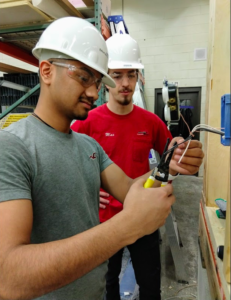KAREN MAHONEY
SPECIAL TO THE CATHOLIC HERALD
Working for STAFF electric, Diego Torres installs electrical systems in new home construction. He  enjoys working outside, electricity and learns something new each day. He is learning on the job and fulfilling a need among the trade industry for qualified professionals.
enjoys working outside, electricity and learns something new each day. He is learning on the job and fulfilling a need among the trade industry for qualified professionals.
The recent Messmer Catholic High School graduate began working as an apprentice following graduation last spring after learning the trade in high school through the Building2Learn Initiative.
“In my freshman and sophomore year, I was thinking about going to college to earn an electrical engineering degree, but one of my teachers told me about the trades and that it might be a nice way for me to learn,” said Torres. “My plan is to apprentice for five years, and then graduate as a journeyman and go to college after that. It will only take a year to get my electrical engineering degree that way. I am making money, gaining knowledge, and always striving for higher education — and it’s a lot cheaper.”
The Building2Learn Consortium is a multi-school, hands-on learning program that models STEM and skilled-trade training and challenges students to develop technical skills, academic proficiency, a practical code of ethics and career plans as they learn to use tools safely in real work environments. The program was designed with an understanding of the economic problems associated with skilled labor shortages and the inadequacies of conventional vocational school education.
Launched in 2014, B2L initiative core leaders Joseph Schmidt, Jim Piatt, Blake Peuse, Joe Weisling, Danny Goldberg, and other regional industry and technical educational leaders met to discuss this new model of secondary education that focused on preparing students for skilled trade apprenticeships and other STEM-related high demand careers.
As a founding member of the B2L Consortium, Jim Piatt, president of Messmer Catholic Schools, explained that the traditional high school to college plan is not always ideal for students.
“In a recent symposium in Metro Milwaukee, the four-year college graduation rate of students that show up for college is just 29 percent and the six-year rate moved to 53 percent, which leaves seven out of 10 students not graduating in four years and five not graduating after six years,” he said. “And the graduation rate of Wisconsin state colleges is even lower.”
Coupled with the low graduation rate, students are racking up considerable college debt and often forced to work at jobs not in their desired field to pay down student loans.
“So, at the same time, in reality, while we certainly feel Messmer and the consortium of private and public schools are college-prep based, it is not always realistic or serving the kids well,” said Piatt. “This program offers the alternative for kids who may not want to go to college, may not be able to afford it and prepares kids with skills where they can go to college later and build on skills they have learned in this program. Of course, none of this effort will reduce kids who are legitimately ready for college from going to college.”
According to Piatt, students involved in the pre-engineering and trades programs are performing better in all subject areas, improving math scores and becoming engaged learners who see value in their subjects.
“They are learning and producing something,” he said. “We have about 150 students in our STEM and trades programs. We have two tract pre-engineering courses that we do through Project Lead the Way. We have now expanded in specific skilled trades to include craftsmanship and residential carpentry. About one out of every four kids is involved and there are waiting lists to get into the courses. It has become so popular that we are launching a renovation program at Messmer this month to convert our old pool into a larger scale Productivity Center to expand the program for the kids.”
Some of the challenges of the B2L program include a dismissive attitude toward vocational training by college-prep schools, despite the fact, that many high school graduates may not be prepared to attend a four-year college degree program immediately after high school. Another challenge is convincing parents that a career in the trades is not second-rate.
At first, Torres needed to convince his college-minded parents that there were benefits associated with apprenticeship followed by a shorter college education.
“They were interested in having me go to college,” he said. “They thought it was the only way to go, but after explaining the program and kind of the basics of the trades and apprenticeship, they sort of got it. They understand it more now. I recommend it. If a student is dedicated, I would say go for it. You need a strong will to do it and you will make it.”
Piatt agreed, adding that part of the consortium is to help parents break down the stigma about the trades and helping them to see it with an open mind.
“One of the ways they are understanding is by letting them know that their son or daughter can get to a sustainable living north of $50,000 in about three years and let them know that through networking and resources, they might be in a better position if they take a college program later in their 20s, rather than right away,” he said. “Our model at Messmer has a character foundation blended in, with safety, teamwork and dedication, encouraging punctuality. We want them to be dependable, honest and trustworthy, which is more essential than knowing how to use power tools.”
